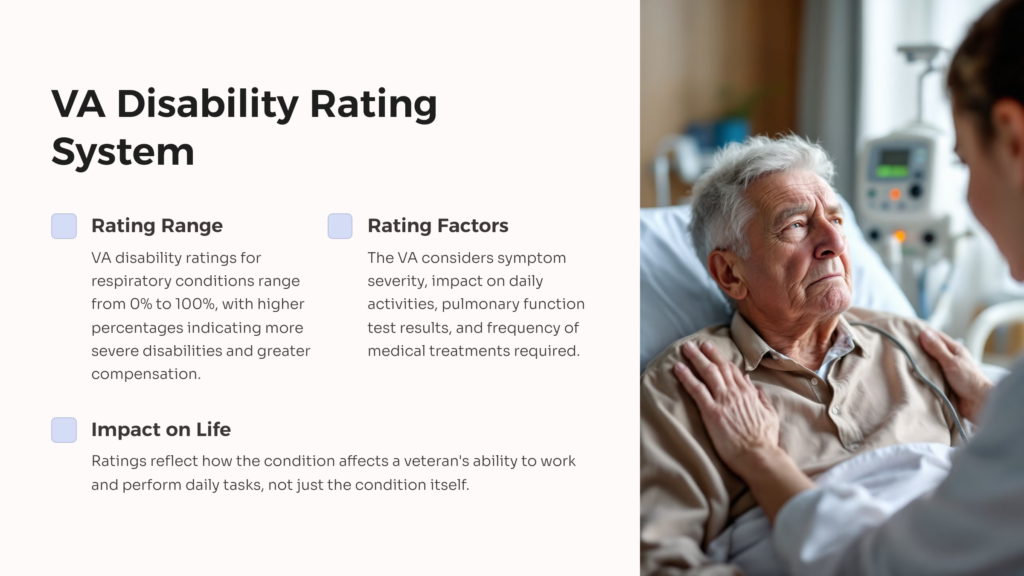What Are VA Disability Ratings?
Veterans often face challenges in navigating life after serving, and understanding the value of a VA disability rating is crucial. A VA disability rating quantifies the severity of conditions linked to military service and determines the level of monthly compensation and vital benefits. The ratings are awarded in increments of 10%, from 0% up to 100%, based on the impact the disability has on the veteran’s overall health and ability to perform everyday activities. These ratings serve as a tangible acknowledgment of the sacrifices made and a means to secure support and resources. Understanding your VA disability rating can provide crucial clarity on the VA system, considering both visible and invisible conditions, such as chronic pain, mental health challenges, hearing loss, or injuries sustained in combat or training. The system is firmly grounded in the principles of fairness and a deep-rooted desire to make the post-service life significantly more sustainable and fulfilling for those brave individuals who have selflessly sacrificed so much for their country and its values.
Typical Challenges Veterans Face
Returning to civilian life is a significant transition for many veterans, characterized by health challenges such as PTSD, traumatic brain injuries, anxiety, and depression. Research from the U.S. Department of Veterans Affairs indicates that 11-20% of veterans who served in Operations Iraqi Freedom and Enduring Freedom experience PTSD annually. These invisible wounds can interfere with daily tasks and lead to less employment stability, increased medical expenses, and emotional distress. The process to access VA disability benefits can be overwhelming, exacerbating stress and anxiety. Family members and close friends also feel these pressures, and tight-knit support networks are often stretched to their limits. Understanding and accessing the VA disability benefits system is crucial for long-term stability.
Step-by-Step Process for Applying
- Gather all service treatment records, civilian medical reports, and any other documents proving your condition’s connection to military service.
- File your claim using the VA’s online portal, by mail, or in person at a local VA office, attaching all relevant documents and fully answering each section.
- Attend any Compensation & Pension (C&P) exams scheduled by the VA. These assessments are crucial for the VA to understand your condition and determine the appropriate rating accurately.
- Respond promptly to all VA requests for additional information or clarification, and keep copies of every exchange for your records.
- Once the VA issues a decision, review your rating carefully. If it appears inaccurate or if information was missed, use the appeals process to request a reevaluation.
Veterans who approach the process systematically—staying organized, tracking deadlines, and maintaining detailed notes—typically avoid common pitfalls. While bureaucratic hurdles are real, breaking the process into manageable steps and advocating for yourself at every stage can make a significant difference.
Common Misconceptions and Mistakes
Misconceptions about VA disability ratings can hinder veterans, such as believing only severe injuries qualify, while mental health or chronic conditions can also justify compensation. Some also believe initial denials are final, but successful claims often result from appeals with new evidence or corrected paperwork. Common issues include errors in paperwork, missing medical appointments, and inadequate documentation. Simple steps, such as double-checking forms, keeping appointments, and updating the VA with address changes, can help avoid frustration and ensure smooth communication.
Role of Medical Evidence
A successful VA claim relies on comprehensive medical evidence, including military service and post-service records, statements from doctors, mental health specialists, and family members. A well-documented “nexus letter” linking the disability to military service can be crucial. Recent upgrades to the VA claims system have enhanced processing efficiency, leading to faster reviews. However, providing extensive, up-to-date medical documentation remains essential for a fair review, even in cases with long wait times.
Financial Impacts on Daily Life
VA disability ratings provide monthly compensation that can be a lifeline for veterans, covering prescription medications, medical devices, physical therapy, and home modifications. Higher ratings can also unlock additional benefits, such as priority healthcare, VA home loans, caregiver support, education and retraining programs, and lower property taxes. With over five million veterans currently receiving disability compensation in the U.S., these ratings serve as a crucial safety net for those most affected by their military service.
Helpful Resources for Veterans
Veteran Service Organizations (VSOs), such as the DAV and American Legion, provide expert advice, assistance with paperwork, and community support to help veterans navigate the VA system. Many states have their own veterans’ agencies and legal assistance networks. Online resources, peer-to-peer networks, and community-based workshops can help guide veterans through the claims process and beyond. Staying informed about VA policy changes and connecting with fellow veterans can alleviate frustration and empower individuals.
Living Well with a VA Disability Rating
VA disability ratings serve as a foundation for growth, independence, and renewed purpose after military service. With the right support network, veterans can use their rating to mentor new service members or advocate for their peers. Living well post-service is achievable through education, adaptive sports, and reconnecting with family. By staying organized, proactive, and connected, veterans can transform a challenging system into a pathway towards empowerment and hope for themselves and others.








